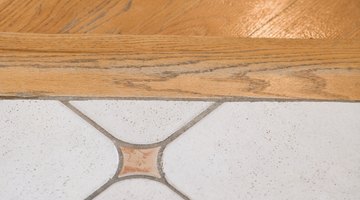How to Determine Which Transition Strips to Use on Flooring
After installing new flooring in one room of your home, you may notice unevenness between where the new flooring and the flooring from an adjoining room meet. An uneven surface can cause you to trip and fall.

One solution is to install a transition strip, or trim molding, to help bridge the gap between the two surfaces and smooth out the transition from one room to the next. Important factors to consider when selecting the transition strip are the flooring types and any height difference between them.
-
Examine the area where the two types of flooring meet and take note of any difference in height. If you are transitioning between a hardwood floor and another hard surface that are approximately the same height, such as wood or ceramic tile flooring, use a T-molding transition strip. If you hold the strip so that you can see its profile, it has a downward stem in the middle and looks like the letter T. To allow for the flooring to expand and contract with changes in the climate, you will need a 1 1/4-inch gap between the two floors. T-molding is installed with construction adhesive.
-
Select a T-molding transition strip if you have installed hardwood flooring in a pattern where the direction of the planks changes within the same room. T-molding strips are available in different thicknesses and with this application you want to use the thinnest ones possible. Many times pre-stained molding is available to match your flooring.
-
Select a multi-purpose reducer strip if you are transitioning between two surfaces of different heights, such as hardwood flooring to a lower vinyl or low-nap carpet. One side of the strip is thin and sits on top of the higher hardwood flooring while the thicker side sits on the lower. This allows for a smooth drop to the lower level. A 1 1/4-inch gap is recommended to allow for the expansion and contraction of the flooring. Reducer transition strips are installed with construction adhesive.
-
Select stair nose transition strips if you have installed flooring on your stair treads, the horizontal surface where your foot lands when walking up stairs. You have two types of strips to choose from. Both cover the front of the step with a rounded edge. The difference is in the back edge; one type butts up flush and level with the installed flooring and the back edge of the other rests on top of the flooring. Both types are installed with construction glue and if installed on wooden stairs, nails are also used to secure the strips.
References
Photo Credits
- Jupiterimages/Comstock/Getty Images
- Jupiterimages/Comstock/Getty Images
More Articles
- How to Keep Rocking Chairs From Damaging Hard Wood Floors
- How to Install Laminate Floor Covering on Curved Surfaces With Transitions
- How to Install a Vinyl Runner on Carpeted Stairs
- How to Install the Transition Strips for Wood Laminate Flooring
- How to Install a Laminate Floor in an Angled Hallway
- How to Make Steep Stairs Bigger



